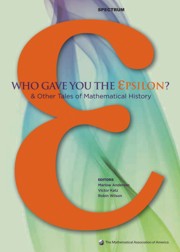Book contents
- Frontmatter
- Introduction
- Contents
- Analysis
- Geometry, Topology and Foundations
- Foreword
- Gauss and the Non-Euclidean Geometry
- History of the Parallel Postulate
- The Rise and Fall of Projective Geometry
- Notes on the History of Geometrical Ideas
- A note on the history of the Cantor set and Cantor function
- Evolution of the Topological Concept of “Connected”
- A Brief, Subjective History of Homology and Homotopy Theory in this Century
- The Origins of Modern Axiomatics: Pasch to Peano
- C. S. Peirce's Philosophy of Infinite Sets
- On the Development of Logics between the two World Wars
- Dedekind's Theorem:√2 × √3 = √6
- Afterword
- Algebra and Number Theory
- Surveys
- Index
- About the Editors
Evolution of the Topological Concept of “Connected”
from Geometry, Topology and Foundations
- Frontmatter
- Introduction
- Contents
- Analysis
- Geometry, Topology and Foundations
- Foreword
- Gauss and the Non-Euclidean Geometry
- History of the Parallel Postulate
- The Rise and Fall of Projective Geometry
- Notes on the History of Geometrical Ideas
- A note on the history of the Cantor set and Cantor function
- Evolution of the Topological Concept of “Connected”
- A Brief, Subjective History of Homology and Homotopy Theory in this Century
- The Origins of Modern Axiomatics: Pasch to Peano
- C. S. Peirce's Philosophy of Infinite Sets
- On the Development of Logics between the two World Wars
- Dedekind's Theorem:√2 × √3 = √6
- Afterword
- Algebra and Number Theory
- Surveys
- Index
- About the Editors
Summary
Introduction
The purpose of this paper is to trace the evolution of one of the most basic concepts in topology, viz., that of connected (not to be confused with simply connected). Like many other mathematical concepts of a fundamental nature (e. g., continuous function), it had only an intuitive meaning (such as connected figurein geometry) until the increasingly subtle demands of analysis and topology forced formulation of a satisfactory definition. The latter was not achieved, as one might expect, until a number of definitions had been proposed—each sufficient with in its mathematical context, but quite insufficient as the configurations studied became more general and abstract.
We try to clear up, incidentally, the existing confusion regarding the actual authorship of the definition ultimately adopted. Not surprisingly, we uncover a “multiple.” For several years, European topologists considered F. Hausdorff to be the prime originator of the definition, apparently because their knowledge of set theory and fundamental topological notions was usually derived from his classic Grundzüge der Mengenlehre [5], published in 1914. However, by the time of publication of his 1944 Mengenlehre [6], which was a third edition of the Grundzüge, Hausdorff had discovered Lennes's earlier version of the same definition (see below), and called attention thereto in a note at the end of his book.
Thereafter the definition was commonly called the “Lennes-Hausdorff definition” of connected. Many modern textbooks on topology seem to have adopted the term “Hausdorff–Lennes Separation Condition”, or “Hausdorff–Lennes condition” for the type of separation involved in the definition.
- Type
- Chapter
- Information
- Who Gave You the Epsilon?And Other Tales of Mathematical History, pp. 142 - 147Publisher: Mathematical Association of AmericaPrint publication year: 2009



